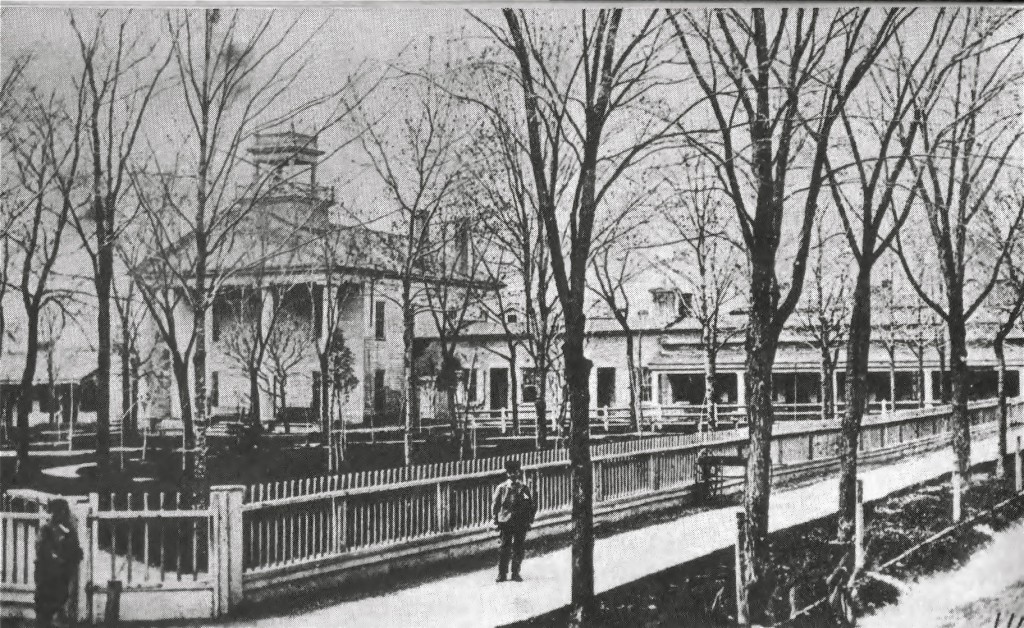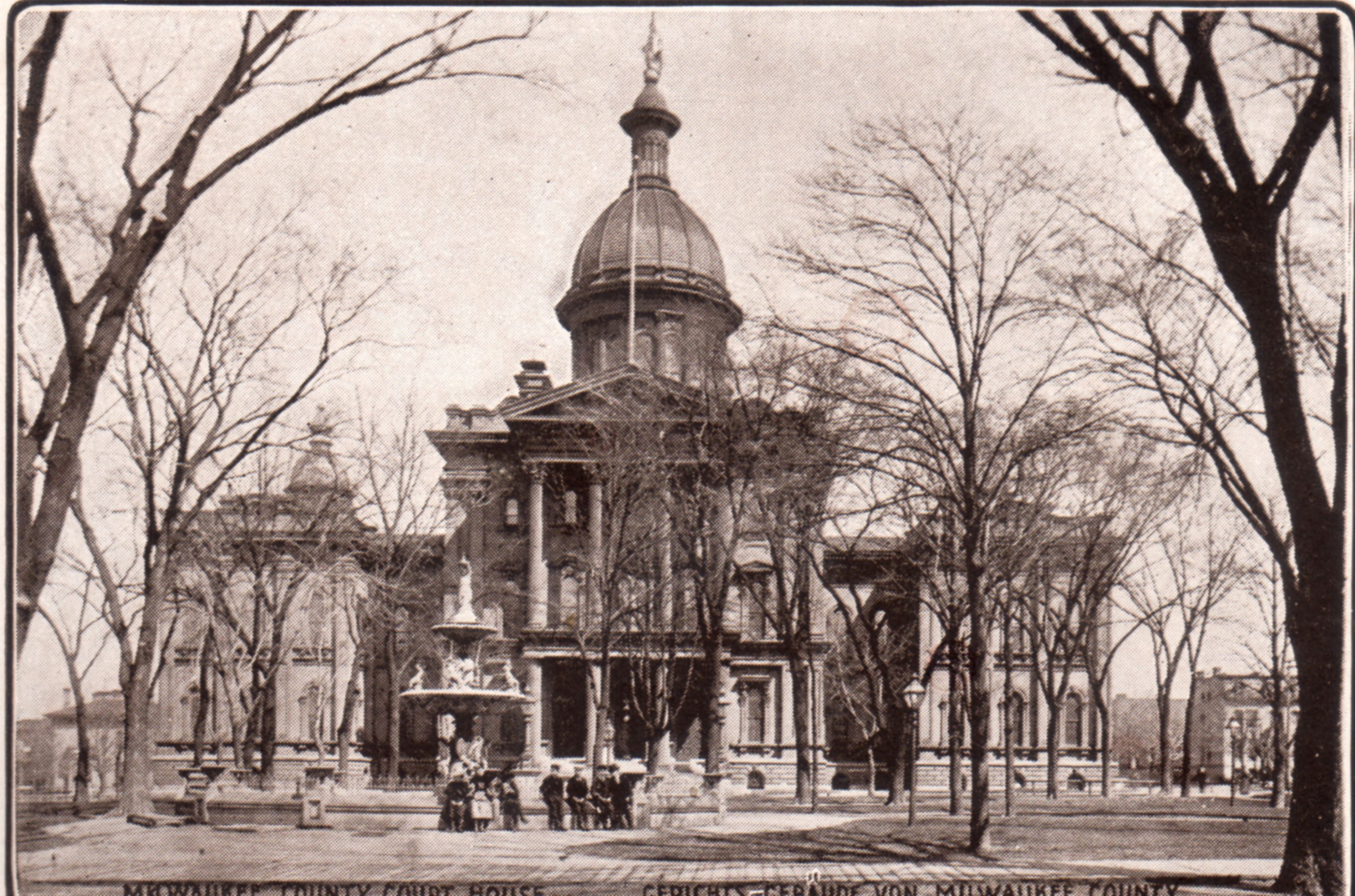
The first courthouse was built in 1836. Additional offices and the jail are to the right. This is the site of Cathedral Park today. Carl Swanson collection
Early settler James S. Buck wrote the four-volume Pioneer History of Milwaukee, which one writer described as “a fascinating hodgepodge of largely undigested facts, gossip, puffs and salty observations.” Buck included events both great and small in the city’s formative years. For example, many historians relate the construction of Milwaukee’s first courthouse in what is today Cathedral Square, but only Buck gave us “The Courthouse Trouser Disaster.”
Solomon Juneau, Milwaukee’s founder, and his business partner, Morgan Martin, built the city’s first courthouse and adjoining jail annex in 1836. The wooden two-story building cost the men $8,000, a considerable sum in those days. On completion, Juneau and Martin, who jointly owned much of what is today the East Side, donated the building and its plot of land to the county.
The first courthouse was “an attractive two-story structure 40 feet wide by 50 feet deep on the north side of the park near what is now Kilbourn Avenue. Its main entrance faced south toward the park.”
It was also deep in the woods in those years and a considerable distance from the little village. At one point in its construction, a worker shingling the roof of the courthouse abruptly dropped his hammer, picked up a rifle and shot a passing deer. A low fence was necessary to prevent cows from grazing on the courthouse lawn. Their mooing was disturbing the process of justice.
The two-story courthouse featured a peaked roof with a cupola on top and a porch across its front. One account said, “It was a white colonial type of building and had a charming effect for so small a structure. The interior contained one courtroom and four jury rooms.”
That courtroom witnessed some of the most dramatic moments in the early settlement. For example, in 1854, three men were tried here for breaking into the city jail and rescuing fugitive slave Joshua Glover. A jury acquitted them.
Thirteen years earlier, Buck had been present at a less significant but equally memorable scene. In 1841, Buck reported, many residents attended a public meeting in the courthouse and sat crowded together on the rows of wooden benches—recently varnished wooden benches, as it turned out.
When the meeting ended, all rose at the same moment, accompanied by a mighty rending of fabric. “There was a great destruction of pants,” Buck wrote, “nearly everyone present leaving a part of the seat of ‘his’n’ as a souvenir. The noise made when they attempted to rise was like the rising from the ground of a thousand pigeons.”

The contract for Milwaukee’s second courthouse was awarded in 1868. Like the original courthouse, it stood in what it today Cathedral Square. Carl Swanson collection
That first courthouse was replaced by a much larger and vastly more ornate structure in 1873, designed by a Russian immigrant, Leonard Schmidtner, who seems to have been inspired by St. Isaac’s Cathedral in Saint Petersburg. (Schmidtner’s real name was Baron von Kowalski, and he was the son of the royal architect of Russia.) The building was often criticized for its clumsy proportions and its odd mix of styles and materials.
Decades after it was constructed, a local architect acidly said, “The building is a typical example of the products of the architects of the period often termed the dark ages in art and architecture.”
The courthouse dome was originally adorned with a gilded wood-and-zinc statue called the Goddess of Liberty. In 1877, a wind storm left the goddess tilted precariously on her perch. Local wits began referring to the “courthouse dancing girl” and suggested she had clearly been drinking. After several failed repair attempts, the statue was hauled down.
Jacob Donges, a local businessman, saved the golden face of the figure from the scrap pile. It is preserved at the Milwaukee County Historical Society.
The second courthouse served Milwaukee until the present courthouse opened ten blocks west in 1931.
There is no trace of the former courthouses in Cathedral Square, although a marker in the two-acre park tells the dramatic story of the freeing of Joshua Glover. It is silent on drunken goddesses and trousers.
Thanks to Karl Bandow and the Historic Milwaukee Architecture group on Facebook for tracking down the disposition of the courthouse statue.
If you enjoyed reading this, you may also enjoy Lost Milwaukee, a new book from The History Press containing the very best from Milwaukee Notebook. Click here for more details.

Congrats on the book Carl
LikeLike
Thanks! And I am glad you are still serving up great posts at iheartliterati — it really makes my day when a new one goes up (and every single time I say, “How does he find this stuff”)!
LikeLike
See, you’ve limited yourself to milwaukee, whereas I have an entire world of trouser disasters and pants destructions to select from! 🙂
LikeLike
I am looking forward to reading the entire book. The parts I’ve seen are very interesting
LikeLiked by 1 person
WHen i was msall , in the 1920’s, we saves our burned out lightbulbs until we had a good quantity. Then we took them to the Electric Company on 2nd and Michigan. they were exchanged for new bulbs. The bulbs were clear glass so we could see the posts with a filament between which smoked and broke when burned out. Do you have anyt information on this?
LikeLike
A couple of interesting points:
The gilded wooden statue that adorned the courthouse was not actually destroyed, but rather moved to the Jacques Donges estate on N. Lake Drive, where it joined his eclectic collection of statuary.
The statue itself, while still in situ, became the subject of an 1887 novel, The Golden Justice, by William Henry Bishop. See: https://babel.hathitrust.org/cgi/pt?id=wu.89099908576;view=1up;seq=7;size=125
LikeLike
Thank you for the additional (and fascinating) insight into the Courthouse statue!
LikeLike